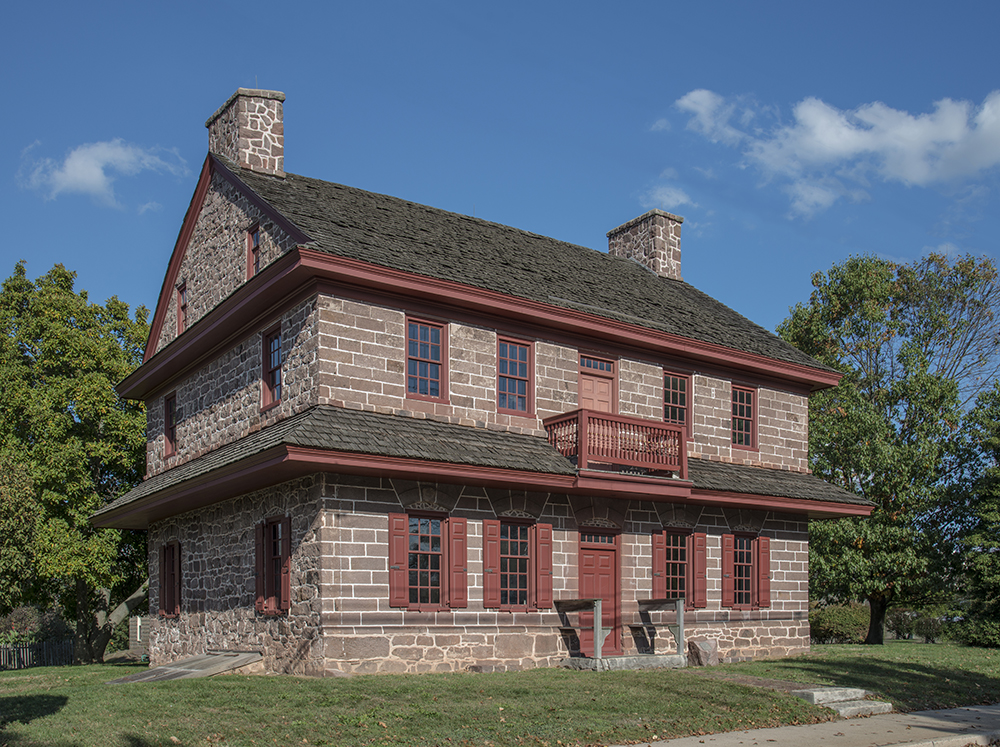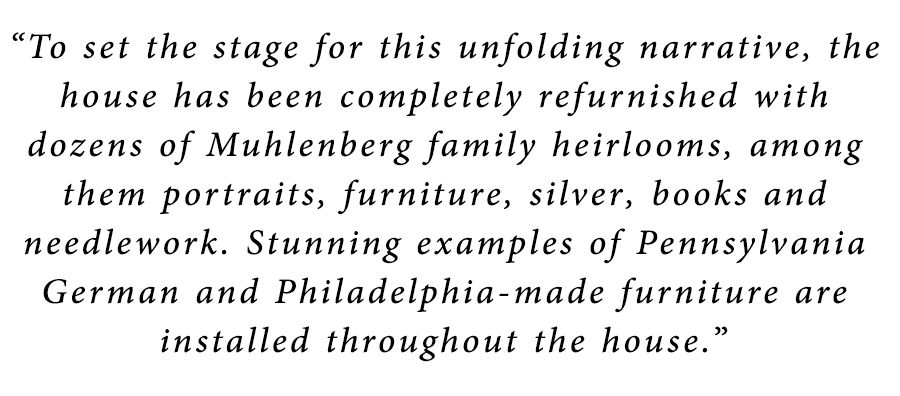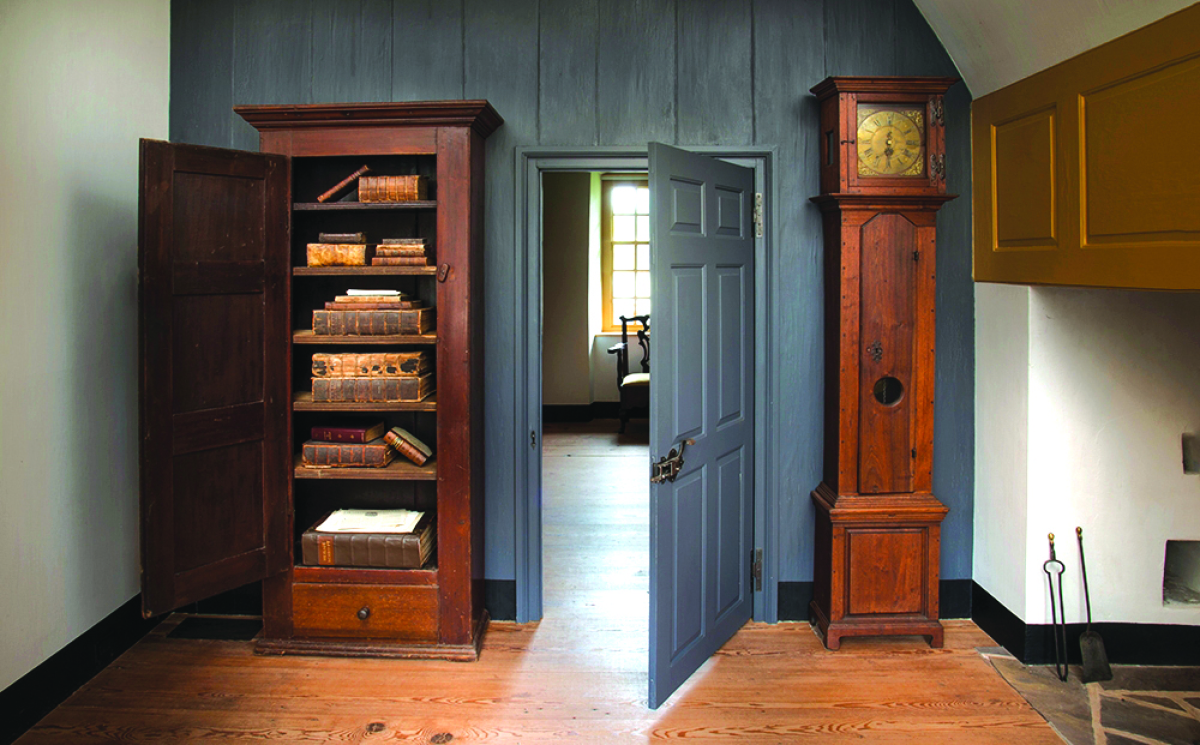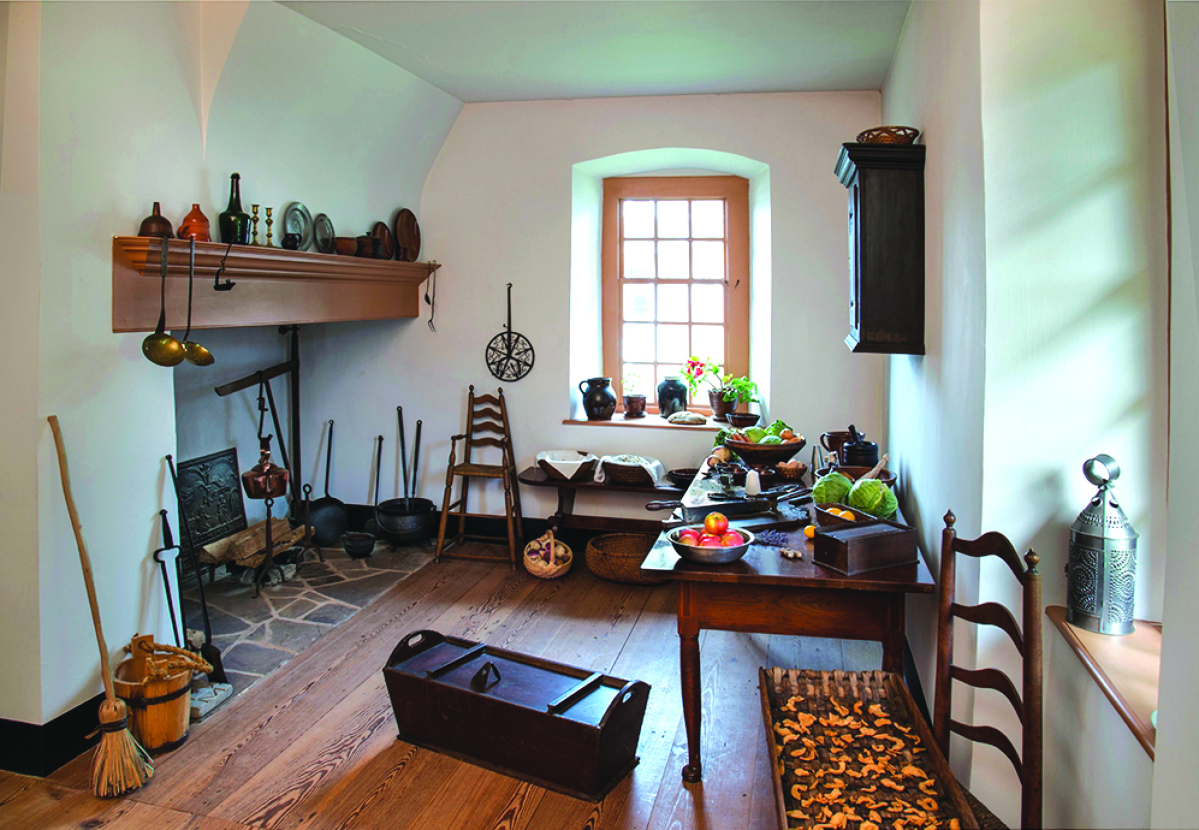
Figure 4. Home of Henry and Mary Muhlenberg, 1776–1787, then Peter and Hannah Muhlenberg, 1787–1802. Built circa 1750–55 by Jacob Schrack Jr, son of the town founder.Onsite photography by Gavin Ashworth.
By Lisa Minardi, Onsite Photos By Gavin Ashworth
TRAPPE, PENN. – Imagine that it is 1787 and you are Henry Melchior Muhlenberg, patriarch of the Lutheran Church in America (fig 1). For 45 years since emigrating from Germany in 1742, you have tirelessly served far-flung congregations and led the Pennsylvania Ministerium. You were able to fulfill your wife Mary’s wish to move out of Philadelphia in 1776 and return to Trappe, where you had first settled together as newlyweds in 1745. But the tumult of war brought chaos to your doorstep anyway, as your cellar was seized by the Continental Army and your church desecrated by soldiers. So much for a quiet retirement in the country.
Much to your dismay, your oldest son, Peter, quit the ministry in 1776 to join the patriots’ cause. You thank God he survived the war, but worry that he abandoned the pulpit. When your second son, Frederick, resigned his pastorate and joined the Continental Congress, you were less than thrilled (fig 2). News that Frederick was elected speaker of the Pennsylvania Assembly did not impress you. Little do you know that in 1789 he will be elected the first Speaker of the US House of Representatives.
At least there is Henry Jr, recently appointed the pastor of Trinity Lutheran Church in Lancaster, but you worry that he is dabbling too much in botany. Mary suffers from frequent seizures and bears the scars from a horrific accident in 1781 when she fell into a kettle of boiling beets. The costs of maintaining the large stone house you now occupy are piling up. If Mary outlives you, how will she ever manage it on her own? Although you still preach occasionally at Augustus Lutheran Church (fig 3), the half-mile walk there from your house exhausts you. You hope people will not notice the folding bench, recently installed in the pulpit and intended to provide respite in case you need it during the two-hour-long service.
 This is the backstory of a major new exhibition at the Henry Muhlenberg House in Trappe (fig 4). Called “Revolution At Home: The Muhlenberg Family of Pennsylvania,” it focuses on the year 1787. In February of that year, Henry and his wife sold their house in Trappe to their son Peter. After Peter and his family moved in, there were three generations living under one roof together with numerous German-speaking servants and two enslaved Africans. Using information gleaned from Henry Muhlenberg’s extensive journals and other family papers, the exhibit recreates a tumultuous year that began with the arrival of Peter’s family – including a new baby and ambitious plans to update the house and its furnishings – and ended with the family patriarch’s death.
This is the backstory of a major new exhibition at the Henry Muhlenberg House in Trappe (fig 4). Called “Revolution At Home: The Muhlenberg Family of Pennsylvania,” it focuses on the year 1787. In February of that year, Henry and his wife sold their house in Trappe to their son Peter. After Peter and his family moved in, there were three generations living under one roof together with numerous German-speaking servants and two enslaved Africans. Using information gleaned from Henry Muhlenberg’s extensive journals and other family papers, the exhibit recreates a tumultuous year that began with the arrival of Peter’s family – including a new baby and ambitious plans to update the house and its furnishings – and ended with the family patriarch’s death.
To set the stage for this unfolding narrative, the house has been completely refurnished with dozens of Muhlenberg family heirlooms, among them portraits, furniture, silver, books and needlework. Stunning examples of Pennsylvania German and Philadelphia-made furniture are installed throughout the house. Artifacts were loaned by numerous Muhlenberg descendants, private collectors and institutions, including the Berks History Center, Chester County Historical Society, Dietrich American Foundation, Rocky Hill Collection, The Speaker’s House and Wunsch Americana Foundation.
Guided tours begin at the front of the house, where visitors are ushered into a dark hallway with five closed doors. Guests may visit Henry or Peter’s side of the house first. The two rooms on the east side of the center hall are believed to be where Henry and Mary Muhlenberg primarily lived after selling the house to Peter. The front room is furnished as Henry’s office, where a slant front walnut desk is set into the deep niche to one side of the fireplace – the extreme opposite corner of the house from the kitchen hearth due to Henry’s intolerance for noise and distractions (fig 5). A large window beside the desk provides ample daylight for reading and writing, along with a commanding view of the road, a major thoroughfare connecting Philadelphia and Reading, Penn.
Across the room but within eyesight of the desk is a 30-hour clock in a locally made walnut case. Next to it is a bookcase packed with dozens of books reflecting Henry’s interests in theology and medicine (fig 6). Among them is a Hebrew bible that he gave to his son Henry Jr shortly before his death. The flyleaf is inscribed with the name of each subsequent owner down to the present direct descendant. Because Henry had some medical knowledge and imported pharmaceutical goods from Germany, there is also a table with various medical implements and supplies.
To the rear of the study is Henry and Mary’s bedchamber, located on the first floor by 1787 due to their age and frailty. The room is crowded with furniture, including an easy chair and commode, to reflect the consolidation of their household belongings. Opposite the bed is a large walnut Kleiderschrank or wardrobe used for storing clothing and other textiles (fig 7). A quintessential type of Germanic storage furniture in affluent households, this example was made in 1765 for George Rahn, who lived within a mile or so of Trappe. To the left of the wardrobe is a small drop leaf table dating to the 1740s. It is the kind of old-fashioned furniture likely to be found in the elderly Muhlenbergs’ private rooms.
Next is the kitchen, where visitors learn about the weighty responsibility of running the household of a busy pastor like Henry Muhlenberg, who was constantly besieged with visitors (fig 8). During the American Revolution, this house was used as a refuge by family members and friends, with up to 30 people all living under one roof. This is also the room where Mary Muhlenberg suffered a horrific accident in 1781, when a seizure caused her to fall into a boiling kettle of beets. Opposite the kitchen hearth is a walnut table that descended in the Muhlenberg family. It has inlaid drawers, an unusual feature for a kitchen worktable.
Through a door to the left of the fireplace is a door to the dining room, where a large oval table is set for an oyster supper hosted by Peter Muhlenberg (fig 9). Both Peter and his brother Frederick are known to have held many such gatherings. Senator William Maclay, a dour Scots Irishman from Pennsylvania, complained in his diary about the excessive eating, drinking and tobacco smoking that characterized the Muhlenberg brothers’ parties. In the far corner is an eight-day clock made by Benjamin Rittenhouse, who lived about ten miles from Trappe. A square piano made by Charles Albrecht of Philadelphia stands in the opposite corner. Albrecht is known to have made one for Peter Muhlenberg in 1803.
A steep staircase leads upstairs to the servants’ chamber, located directly above the kitchen (fig 10). Here, visitors are confronted with the crowded but spare quarters occupied by the enslaved African and German-speaking servants whose labor enabled the Muhlenbergs to live in relative ease and comfort.
Opposite this room is the bedchamber of Peter and Hannah Muhlenberg, where an elegant mahogany tester bed makes a pointed contrast to the humble pallets of the servants’ quarters (fig 11). A walnut cradle and child-size ladder back chair speak to the presence of young children, including newborn Peter Jr and his 3-year-old sister Esther, known as Hetty to the family. Above the chair is a silkwork embroidery stitched by Hetty in 1797 at age 13.
The master bedchamber connects to an upstairs parlor, where a tea table is placed directly above the desk in Henry’s office below (fig 12). Much to Henry’s dismay, his daughter-in-law began entertaining several neighboring women soon after moving in. To the privacy of his journal, he complained that “they drink a glass of wine or cup of tea and some cakes…and entertain one another with vain conversation.” On the tea table is an urn-shaped silver sugar bowl made for Frederick and Catharine Muhlenberg by Christian Wiltberger of Philadelphia. It is engraved with their initials, as is the English silver creamer beside it. The pair of mahogany chairs flanking the table are from a set of 12 made in 1763 for Henry Muhlenberg by Leonard Kessler, a German Lutheran cabinetmaker in Philadelphia whom the family often patronized.

Figure 6. The bookcase holds Eighteenth Century German theological works, bibles and medical books. From his desk, Henry Muhlenberg could easily glance over at the clock, which is a 30-hour movement housed in a locally made walnut case. The ample use of wooden pegs in the case’s construction indicates it was built by a German craftsman.
Across the room is a card table with mother-of-pearl inlay that descended in the Muhlenberg family. Samples of reproduction wallpaper from the late 1700s are a touchpoint to discuss Peter and Hannah’s efforts to redecorate the house according to the latest fashions. Henry groused to his journal about the “considerable disturbance” when the new wallpaper was installed in late April, before the younger couple had even moved in. Looming over the room is a striking portrait of Peter Muhlenberg, attributed to John Trumbull, wearing a blue and buff uniform from the Continental Army (fig 13).
The final room in the house is installed as an art gallery, with family portraits hung on the walls and cases of smaller artifacts throughout the room. Highlights include a stunning serpentine front card table made for Henry’s youngest child, Sally, and her husband, Matthias Richards Jr, in the shop of cabinetmaker Daniel Rhein of Reading, Berks County, Penn. (fig 14). Several of the portraits are important new discoveries, including one of Henry Jr attributed to Jacob Eichholtz and a long-lost portrait of Catharine (Schaeffer) Muhlenberg, Frederick’s wife, painted by Joseph Wright, circa 1790, along with a companion portrait of Frederick that is owned by the National Portrait Gallery. Nearby is a silver tea service made for their son David Muhlenberg, a renowned steam engineer, and his wife Rachel by Thomas Fletcher and Sidney Gardiner of Philadelphia.
“Revolution At Home” was organized in conjunction with the town of Trappe’s 300th anniversary celebrations in 2017. With advance reservations, one can tour the Augustus Lutheran Church, built in 1743 and a National Historic Landmark. Just four doors east of the Henry Muhlenberg House is the home of Frederick Muhlenberg. Now known as The Speaker’s House, the main structure was built in 1763 with two later stone additions. It was rescued from demolition by a nonprofit organization that is now working to restore the house to the period of the Muhlenbergs’ ownership, from 1781 to 1803, and open it to the public as a museum. The Speaker’s House is open for tours by appointment while it is undergoing restoration and for special events. For more information, visit www.speakershouse.org.
“Revolution At Home: The Muhlenberg Family of Pennsylvania” runs through December 31. The Henry Muhlenberg House is at 201 West Main Street. It is owned and operated by the Historical Society of Trappe, Collegeville, Perkiomen Valley. Guided tours are offered during the society’s regular hours or by advance appointment. Contact info@historictrappe.org for reservations. For more information about the exhibit, visit www.historictrappe.org.
Lisa Minardi is curator of the the “Revolution At Home” exhibit and co-chair of the Trappe 300 Steering Committee. She is the author of Pastors & Patriots: The Muhlenberg Family of Pennsylvania.






















